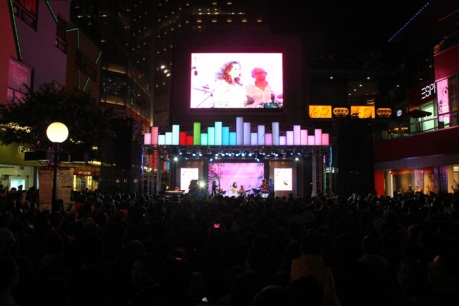…
I’d also like to be wise.
In the old books is written what is wise:
Stay out of the world’s argy-bargy and spend
Your short span without fear,
Also make do without violence,
Repay evil with good,
Don’t fulfil your wishes but forget them,
All that is seen as wise.
All that I cannot.
Really, I live in dark times!
Bertolt Brecht, To the Descendants
 Opening Meeting of CPPCC Plenary Session, 03.03.2012 (from: China.org.cn)
Opening Meeting of CPPCC Plenary Session, 03.03.2012 (from: China.org.cn)
Recently Jörg Leeser and I received an email from one of the former participants of our Sino-German Community Workshop in Chongqing. I was happy to hear, that during the last weeks the former participants of our workshop „made some research and surveys for different groups in the Da Jing Xiang community, and worked out a more detailed plan. Finally, [they] decided to build an outdoor space with different levels like big stairways or […] stone tables where the children in this community can do their homework. During [their] survey [they] found out that most of the elementary students here are complaining about not having a outdoor playground. And [they] thought [to] composite those demanding together and come up with a multifunctional installation ([…]merely a architecture and much bigger than an installation).“
But unfortunately, since the whole plan seems now to be suspended because of „financial problems“, and since this year there have been also some personal changes in the Planning committee of the DuC-project, the next steps of the Sino-German collaboration are not clear at this time.
In the meantime I had also started to think with Prof. Li Yifan from the Sichuan Fine Arts Institute about a collaborative site specific public art project in Chongqing. We are planning to deal with texts by Brecht as a starting point, and want to realize a performative installation beneath the Unfinished Elevated Highway next to the touristic area of Ciqikou. The funding for this project seems to be warranted, but we are still waiting for the „official starting signals“ for our collaboration in Chongqing. While there also have been some recent personal changes in the political administration of Chongqing ( http://www.ft.com/intl/cms/s/0/7dbe2368-6dbf-11e1-b98d-00144feab49a.html#axzz1qKDPvTHt), i really hope to be back in Chongqing soon.
During the last years, the notion of „soft power“ became a frequently discussed topic among the Chinese political elite, in the Chinese academic discourse and in the national press. Academics analysed „cultural strategies“ of different foreign countries such as France, the US or Germany (it is f.e. interesting to see, how the „function and worldwide impact“ of the German Goethe Institut is seen from a „Chinese perspective“), and since the political debate about a national cultural policy is nothing new at all, it is not a big surprise to see that the development of China’s cultural sector is now a central initiative for 2012 and the next years. In January an essay from President Hu Jintao was published in the Communist Party magazine „Seeking Truth“, based on a speech he gave in 2011, where he described that the cultures of the West and the East are engaged in an „escalating confrontation with each other“, and that „building a strong and international competitive national culture“ has to be one of the core aims for the next couple of years:
“We must clearly see that international hostile forces are intensifying the strategic plot of Westernisation and dividing China, and ideological and cultural fields are the focal areas of their long-term infiltration. […] The overall strength of Chinese culture and its international influence is not commensurate with China’s international status. […] In short, the whole party should implement the good spirit of the plenary session, struggling to create a new dimension in the construction of socialist culture in the process of building a moderately prosperous society in scientific development on the road.”
Against this background it might be interesting to have a look into a study by the German Heinrich Böll foundation that diagnoses, that in 2008 „a little bit more than 50% off all identified articles published in the German media landscape and explicitly dealing with China are only referring to China in an allegorical and stereotypical manner.“ This report, published in 2010, draws the following conclusion: „Altogether we can talk here about a continuous distribution of existing stereotypes via the media, which orientate themselves more on social fixed symbols and flowery phrases, than on their original task to reflect these images.“
I am convinced that respect, the curiosity to learn from each other and a transparent and open dialogue – the basic pre-conditions of each sucessful partnership – are (still) some of the greatest challenges for the 21. century, and that we have to continue with our collaborative efforts, to bring some „light“ to the „dark areas“ of “Black-and-white thinking”. Suspicion and fear are not our best advisers, as history has proven more than once. Of course, there is nothing bad about being a little bit „careful“ and „pro-active“ – we cannot allow ourselves to be naive in the „power play“ that we all are a small part of, this was one of the first lessons many former colonized countries had to learn the hard way -, but neither arrogance nor closeness will provide sustainable solutions. This is true for all nations.
Art can provide a very precious space to deal with some of our fears: It can help us to accept what is different and face „the other“, reminding us about the one common criterion, that always has to be appreciated everywhere: the human life. While the capitalist system certainly is intrinsically tied to notions such as „power“, „business“, „purpose“, „accumulation“, „advantage“ and „strategy“, the virtual aim of an „independent“ art can at least help us to take a small step aside.





















